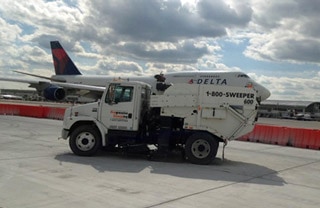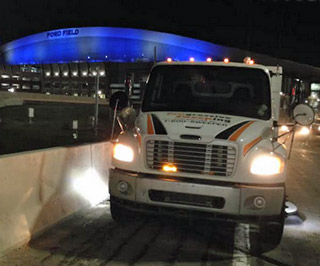Autumn leaves provide a burst of twirling, majestic color to our world for a few weeks each year before they promptly become a huge nuisance for months after that. Because of this, it is tempting to simply leave these crunchy burdens where they fall and wait for old man winter to cover them up. However, this can pose some very real environmental and financial threats so before you let sleeping leaves lie, consider the importance of getting them properly swept.
Environmental Impact of Fall Leaves on Stormwater Runoff
It’s easy to see how all those individual leaves really add up as we try to walk through them in parking lots, on sidewalks and lawns. Now if these leaves are a problem in those places, just imagine what they can do when they are blown or washed into stormwater runoff. Once they are part of stormwater they can lead to clogged catch basins, clogged storm drains and reduced water quality. Because stormwater runoff, by definition, is water that runs into the nearest body of water and is not treated, it is especially important to keep as many impurities out of this as possible.
What are the consequences of clogged storm drains?
When storm drains (also known as catch basins) get clogged with recently fallen leaves and debris, water can no longer be drained from the street. Water ponds along streets and can flood intersections and homes. Localized street flooding can be a hazard to the traveling public.
Contrary to popular belief, pet wastes, oil and other materials dumped into catch basins do not always go to the wastewater treatment plant, but instead may flow directly into streams and rivers. For example: dumping oil into a storm drain can have almost unthinkable consequences. If it reaches a river, lake, or stream, five quarts of oil can create a slick as large as two football fields and persist on mud or plants for six months or more.
It is important to monitor and clean catch basins to prevent street flooding, property damage, and hazards to the traveling public.
Burning is not your Friend
Burning leaves is an old and, admittedly, effective way of disposing of fall leaves, however, many cities have ordinances against this for good reason. Toxins given off by burning leaves have a particularly nasty effect on anyone with asthma and other persons such as the elderly, children and smokers are even more susceptible to the consequences of lung irritation brought on by the excess smoke. Also, if your city does have an ordinance against burning then you can stand to be charged a very inconvenient fine.
Even More Reasons for Proper Fall Leaf Cleanup
Both stormwater quality and the issues of burning may seem fairly obvious but here are a few other aspects many do not think about when they consider fall leaf cleanup:
- Professional Aesthetics: Often, one of the first impressions a customer has of a business is the way the business’s storefront and parking lot are maintained. Leaving dry, or worse yet, soggy leaves strewn about your parking lot is unsightly and, if bad enough, may even take up a parking space or two if the leaves are pushed to an area but not properly bagged after.
- Safety Hazard: We’ve all encountered a pile of leaves that has been smashed down, wetted, smashed down again and wetted once more until it resembles something more like brown sludge than leaves. This muck can be seriously slippery and could easily result in a slip and fall accident.
It is easy to avoid these problems, though, by investing in proper sweeping and disposal of leaves and debris from parking lots, sidewalks, and roadways. 1-800-SWEEPER partners are a mere phone call away with a local contractor in your area to help with all your sweeping needs for a happier, healthier fall season!



